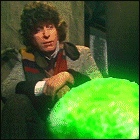 Leela is unimpressed when the TARDIS once again arrives on Earth, and on another foggy night to boot. But this time, she and the Doctor have landed near a lighthouse on a particularly treacherous rocky shoreline at the turn of the 20th century. The lighthouse’s three-man crew is having trouble keeping their beacon lit, which leads to a ship running aground shortly after the Doctor and Leela make their presence known. But something else has made its presence known to at least one of the men – by killing him and assuming his shape. The survivors of the shipwreck make their way to the lighthouse, each with their own agenda blinding them to what could be the beachhead of an alien invasion. By the time the Doctor reveals the true nature of the threat to them, the alien visitor has claimed more victims.
Leela is unimpressed when the TARDIS once again arrives on Earth, and on another foggy night to boot. But this time, she and the Doctor have landed near a lighthouse on a particularly treacherous rocky shoreline at the turn of the 20th century. The lighthouse’s three-man crew is having trouble keeping their beacon lit, which leads to a ship running aground shortly after the Doctor and Leela make their presence known. But something else has made its presence known to at least one of the men – by killing him and assuming his shape. The survivors of the shipwreck make their way to the lighthouse, each with their own agenda blinding them to what could be the beachhead of an alien invasion. By the time the Doctor reveals the true nature of the threat to them, the alien visitor has claimed more victims.
Season 15 Regular Cast: Tom Baker (The Doctor), Louise Jameson (Leela), John Leeson (voice of K9)
written by Terrance Dicks
directed by Paddy Russell
music by Dudley SimpsonGuest Cast: Colin Douglas (Reuben / voice of the Rutan), John Abbott (Vince), Ralph Watson (Ben), Alan Rowe (Colonel Skinsale), Sean Caffrey (Lord Palmerdale), Annette Woollett (Adelaide), Rio Fanning (Harker)
Broadcast from September 3 through 24, 1977
LogBook entry & review by Earl Green
Review: Perhaps not really viewed as one of the quintessential Tom Baker stories – it’s no Genesis Of The Daleks or Talons Of Weng-Chiang – The Horror Of Fang Rock succeeds in creating a tense enclosed atmosphere almost despite itself. The story and the characters inhabiting it are interesting enough, but it’s the physical space they inhabit that tends to stretch credibility a bit. Horror tries to simulate a Victorian lighthouse with huge walls of bluescreen, and there are times when they just about pull it off – there’s actually one brief shot of the Doctor clinging to the exterior of the lighthouse that’s a very good piece of effects work – but there are at least as many times where the attempt at creating this setting comes off as fake. Considering that this was the first story to air after the theatrical premiere of Star Wars (the first episode was actually shot in the studio on the very day that movie debuted), it was a bold try…and a necessary one, since one can barely imagine filming in the light room of a real lighthouse at night, let alone getting permission to turn that light off at dramatically necessary junctures of the story!
Where Horror succeeds is in throwing a whole school of red herrings at the viewer to hold off the revelation of the real threat. Though I’m strongly tempted to label the various secondary plots as padding, they actually hold their own and provide  a useful way to keep our heroes from calling for backup. It’s doubly surprising that the motivations and portrayals that keep the secondary story strand going are as relatively adult as they are; I don’t mean Torchwood adult here, but adult as in blackmail, con jobs, motivations for murder, and at least one utterance each of “hell” and “damn” at a time when Doctor Who was still widely considered a children’s show. Horror marks the transition into the era of Graham Williams, the penultimate producer of the original series, whose reign is often criticized as the nadir of the show in the 70s, with Tom Baker’s tongue-in-cheek tendencies becoming harder to repress. But this feels like a Hinchcliffe story. And the change in tone would be rather sudden: the following story introduced K-9 and began to tone things down considerably.
a useful way to keep our heroes from calling for backup. It’s doubly surprising that the motivations and portrayals that keep the secondary story strand going are as relatively adult as they are; I don’t mean Torchwood adult here, but adult as in blackmail, con jobs, motivations for murder, and at least one utterance each of “hell” and “damn” at a time when Doctor Who was still widely considered a children’s show. Horror marks the transition into the era of Graham Williams, the penultimate producer of the original series, whose reign is often criticized as the nadir of the show in the 70s, with Tom Baker’s tongue-in-cheek tendencies becoming harder to repress. But this feels like a Hinchcliffe story. And the change in tone would be rather sudden: the following story introduced K-9 and began to tone things down considerably.
That’s not to say that Horror is too serious for its own good. There are plenty of classic Tom Baker moments, but not having seen this story since the very first time I saw it as a child, I’m struck by how subdued and somber Baker’s performance is here, particularly when he realizes, in the episode 3 cliffhanger, that he’s locked the real danger in the lighthouse rather than locking it outside. But the real prize here has to go to Louise Jameson. A lot of development for Leela is built into the dialogue, including her admission that she now trusts science more than superstition, but Jameson brings a naivete to the character that fits. She doesn’t know how to handle a shovel, and doesn’t know that there’s anything wrong with starting to disrobe in front of someone she’s just met so she can ditch her frilly clothes for something more utilitarian. On the other hand, she’s completely oblivious to an attempt by one of the lighthouse crew to chat her up, but it doesn’t break the character to do that.
As low-key as The Horror Of Fang Rock is, compared to the stories immediately before and after it, it has a lot to recommend it.

